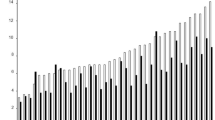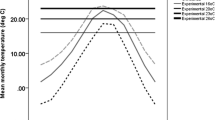Abstract
Drosophila sechellia is a specialist species which feeds and breeds on a toxic plant, Morinda citrifolia. All other Drosophila species are killed by ripe fruits of Morinda. D. simulans was subjected to laboratory selection for survival in presence of octanoic acid, the toxic compound of M. citrifolia. After 20 generations of selection, selected lines showed an increased tolerance to octanoic acid, although the response was small compared to the interspecific differences. The genetic response to selection was assessed by studying the changes in allele frequencies at 28 microsatellite loci. Three loci, located in three distinct genomic regions, showed changes in allele frequencies significantly different from what is expected under drift alone in the selected lines. An oligogenic determination for tolerance to octanoic acid is in agreement with published results based on interspecific crosses.
Similar content being viewed by others
References
Amlou, M., Moreteau, B. and David, J.R. (1998) Larval tolerance in the Drosophila melanogaster species complex toward the two toxic acids of the D. sechellia host plant. Hereditas 129, 7–14.
Amlou, M., Pla, E., Moreteau, B. and David, J.R. (1997) Genetic analysis by interspeci.c crosses of the tolerance of Drosophila sechellia to major aliphatic acids of its host plant. Genet. Sel. Evol. 29, 511–522.
Ashburner, M. (1989)Drosophila: a laboratory handbook. Cold Spring Harbour Laboratory Press.
Colson, I., Macdonald, S.J. and Goldstein, D.B. (1999) Microsatellite markers for interspecific mapping of Drosophila simulans and D. sechellia. Mol. Ecol. 8, 1951–1956.
Crow, J.F. and Kimura, M. (1970) An introduction to population genetics theory. Harper and Row, New York.
Darvasi, A. and Soller, M. (1995) Advanced intercross lines, an experimental population for fine genetic mapping. Genetics 141, 1199–1207.
Farine, J.-P., Legal, L., Moreteau, B. and Le Quere, J.-L. (1996) Volatile components of ripe fruits of Morinda citrifolia and their effects on Drosophila. Phytochemistry 41, 433–438.
ffrench-Constant, R.H. (1994) The molecular and population genetics of cyclodiene insecticide resistance. Insect Biochem. Mor. Biol. 24, 335–345.
Fisher, R.A. (1930) The genetical theory of natural selection. Oxford University Press, Oxford.
Garcia, N., Lopez-Fanjul, C. and Garcia-Dorado, A. (1994) The genetics of viability in Drosophila melanogaster; effects of inbreeding and artificial selection. Evolution 48, 1277–1285.
Harshman, L.G. and Hoffmann, A.A. (2000) Laboratory selection experiments using Drosophila: what do they really tell us? Trends Ecol. Evol. 15, 32–36.
Irvin, S.D., Wetterstrand, K.A., Hutter, C.M. and Aquadro, C.F. (1998) Genetic variation and differentiation at microsatellite loci in Drosophila simulans: evidence for founder effects in New World populations. Genetics 150, 777–790.
Jones, C.D. (1998) The genetic bases of Drosophila sechellia's resistance to a host plant toxin. Genetics 149, 1899–1908.
Jones, C.D. (2001) The genetic basis of larval resistance to a host plant toxin in Drosophila sechellia. Genet. Res. 78, 225–233.
Kimura, M. (1983) The neutral theory of molecular evolution. Cambridge University Press, Cambridge, UK.
Kliman, R.M., Andolfatto, P., Coyne, J.A., Depaulis, F., Kreitman, M., Berry, A.J., McCarter, J., Wakeley, J. and Hey, J. (2000) The population genetics of the origin and divergence of the Drosophila simulans complex species. Genetics 156, 1913–1931.
Lande, R. (1983) The response to selection on major and minor mutations affecting a metrical trait. Heredity 50, 47–65.
Legal, L., Chappe, B. and Jallon, J.-M. (1994) Molecular basis of Morinda citrifolia (l.): toxicity on Drosophila. J. Chem. Ecol. 20, 1931–1943.
Legal, L., David, J.R. and Jallon, J.-M. (1992) Toxicity and attraction effects produced by Morinda citrifolia fruits on the Drosophila melanogaster complex of species. Chemoecology 3, 125–129.
Legal, L. and Plawecki, M. (1995) Comparative sensitivity of various insects to toxic compounds from Morinda citrifolia (L.). Entomol. Probl. 26, 155–159.
Louis, J. and David, J.R. (1986) Ecological specialization in the D. melanogaster species subgroup: a case study of D. sechellia. Acta Oecol., Oecol. Gen. 7, 215–219.
Macdonald, S.J. and Goldstein, D.B. (1999) A quantitative genetic analysis of male sexual traits distinguishing the sibling species Drosophila simulans and D. sechellia. Genetics 153, 1683–1699.
Orr, H.A. (1998) The population genetics of adaptation: the distribution of factors fixed during adaptive evolution. Evolution 52, 935–949.
Orr, H.A. (1999) The evolutionary genetics of adaptation: a simulation study. Genet. Res. 74, 207–214.
Orr, H.A. and Irving, S. (1997) The genetics of adaptation: the genetic basis of resistance to wasp parasitism in Drosophila melanogaster. Evolution 51, 1877–1885.
Partridge, L. and Fowler, K. (1992) Direct and correlated responses to selection on age at reproduction in Drosophila melanogaster. Evolution 46, 76–91.
Pigliucci, M. and Kaplan, J. (2000) The fall and rise of Dr Pangloss: adaptationism and the Spandrels paper 20 years later. Trends Ecol. Evol. 15, 66–70.
Raymond, M.L. and Rousset, F. (1995a) An exact test for population differentiation. Evolution 49, 1280–1283.
Raymond, M.L. and Rousset, F. (1995b) GENEPOP (version 1.2): population genetics software for exact tests and ecumenicism. J. Hered. 86, 248–249.
R'Kha, S., Capy, P. and David, J.R. (1991) Host-plant specialization in the Drosophila melanogaster species complex: a physiological, behavioral, and genetical analysis. Proc. Natl. Acad. Sci. USA 88, 1835–1839.
Rose, M.R., Nusbaum, T.J. and Chippindale, A.K. (1996) Laboratory evolution: the experimental wonderland and the Cheshire cat syndrome. In M.R. and L.G.V. Rose (eds) Adaptation. Academic Press, San Diego, pp. 221–241.
Roush, R.T. and McKenzie, J.A. (1987) Ecological genetics of insecticide and acaricide resistance. Annu. Rev. Entomol. 32, 361–380.
Rozen, D.E., Arjan, J., deVisser, G.M. and Gerrish, P.J. (2002) Fitness effects of fixed beneficial mutations in microbial populations. Curr. Biol. 12, 1040–1045.
Shirley, M.D.F. and Sibly, R.M. (1999) Genetic basis of a between-environment trade-off involving resistance to Cadmium in Drosophila melanogaster. Evolution 53, 826–836.
Sokal, R.S. and Rohlf, F.J. (1995) Biometry. W.H. Freeman and company, New York.
Tsacas, L. and Bachli, G. (1981) Drosophila sechellia. n. sp., huitieme espece du sous-groupe melanogaster des iles Seychelles (Diptera, Drosophilidae). Revue Francaise d'Entomologie 3, 146–150.
Van Oosterhout, C., Zijlstra, W.G., Van Heuven, M.K. and Brakefield, P.H. (2000) Inbreeding depression and genetic load in laboratory metapopulations of the butterfly Bicyclus anynana. Evolution 54, 218–225.
Weir, B.S. and Cockerham, C.C. (1984) Estimating F-statistics for the analysis of population structure. Evolution 38, 1358–1370.
Author information
Authors and Affiliations
Rights and permissions
About this article
Cite this article
Colson, I. Drosophila simulans' response to laboratory selection for tolerance to a toxic food source used by its sister species D. sechellia . Evolutionary Ecology 18, 15–28 (2004). https://doi.org/10.1023/B:EVEC.0000017669.56353.cb
Issue Date:
DOI: https://doi.org/10.1023/B:EVEC.0000017669.56353.cb




